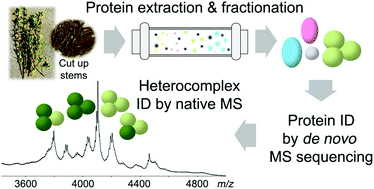De novo sequencing and native mass spectrometry revealed hetero-association of dirigent protein homologs and potential interacting proteins in Forsythia × intermedia†
Abstract
The discovery of dirigent proteins (DPs) and their functions in plant phenol biochemistry was made over two decades ago with Forsythia × intermedia. Stereo-selective, DP-guided, monolignol-derived radical coupling in vitro was then reported to afford the optically active lignan, (+)-pinoresinol from coniferyl alcohol, provided one-electron oxidase/oxidant capacity was present. It later became evident that DPs have several distinct sub-families, presumably with different functions. Some known DPs require other essential enzymes/proteins (e.g. oxidases) for their functions. However, the lack of a fully sequenced genome for Forsythia × intermedia made it difficult to profile other components co-purified with the (+)-pinoresinol forming DP. Herein, we used an integrated bottom-up, top-down, and native mass spectrometry (MS) approach to de novo sequence the extracted proteins via adaptation of our initial report of DP solubilization and purification. Using publicly available transcriptome and genomic data from closely related species, we identified 14 proteins that were putatively associated with either DP function or the cell wall. Although their co-occurrence after extraction and chromatographic separation is suggestive for potential protein–protein interactions, none were found to form stable protein complexes with DPs in native MS under the specific experimental conditions we have explored. Interestingly, two new DP homologs were found and they formed hetero-trimers. Molecular dynamics simulations suggested that similar hetero-trimers were possible between Arabidopsis DP homologs with comparable sequence similarities. Nevertheless, our integrated mass spectrometry method development helped prepare for future investigations directed to the discovery of novel proteins and protein–protein interactions. These advantages can be highly beneficial for plant and microbial research where fully sequenced genomes may not be readily available.



 Please wait while we load your content...
Please wait while we load your content...